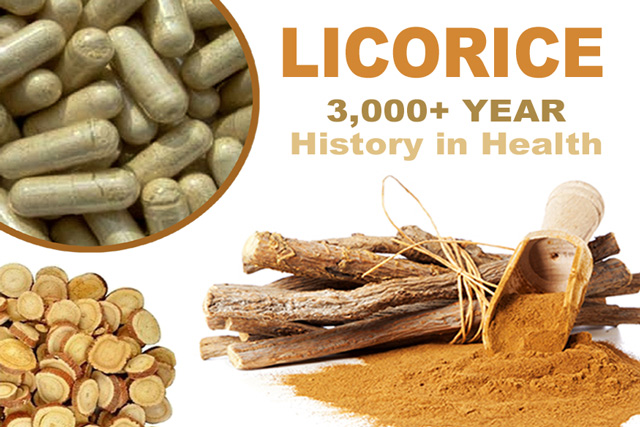Have you ever wondered why licorice root is an ingredient in many whole food supplements?
Most people just think of licorice as a chewy black candy.
Sadly, most “licorice” candy today doesn’t even contain any real licorice. But licorice root is used for much more than candy. It is a potent medicinal food with a long history dating back literally thousands of years.
If you visited a naturopath/herbalist today, you might be surprised at the wide range of conditions licorice is recommended for:
Asthma, athlete’s foot, body odor, canker sores, chronic exhaustion, fungal infections, ulcers, liver problems, psoriasis, shingles, sore throat, emphysema, yeast infections, ulcers, gout, heartburn, hormonal problems, herpes, shingles, cold sores and adrenal fatigue.
That is why licorice is an ingredient in many whole food supplements—it nutritionally supports a wide array of medical conditions.
Licorice history dates back to ancient Egypt and Babylon
Believe it or not, the ailments known to benefit from licorice have not changed much in thousands of years.
The ancient Egyptians considered licorice a cure-all and administered it for dozens of medical conditions.
Licorice was found in great quantities in the tomb of King Tut, who died approximately 3,325 years ago. The licorice was set in the tomb alongside gold, jewelry and art treasures.
Alexander the Great (356 BC – 323 BC) provided licorice root to his army, which used the powerful herb readily. It was reported to be especially beneficial on long marches.
Pedanius Dioscorides, an herbal physician who authored De Materia Medica on medicinal plants, traveled with the army and recorded use of licorice root for a number of different ailments.
Soldiers chewed licorice root to allay thirst and to give them stamina and endurance.
It was reported that under emergency situations the troops could go 12 days without water by chewing licorice root.
Hundreds of years later, the Romans followed suit and also used licorice root as a nutritional supplement for their troops.
About 70 AD the Roman scientist and statesman Pliny the Elder recommended licorice root to clear the voice and throat and to alleviate thirst and hunger.
Every major culture made use of medicinal licorice
It was also used by the ancient Brahmans of India, Hindus, Babylonians and Chinese.
In the Middle Ages licorice root was used to alleviate bad effects of contaminated meats and highly spiced and overcooked foods. It was so valued that a tax was placed on licorice imports to aid in the repair of the London Bridge in 1305.
By the 15th century, licorice root was first listed among important medicines in Italian apothecaries, followed by German apothecaries.
Planting and growing licorice root began in England about 1558, under the reign of Queen Elizabeth.
It was the English who introduced licorice root to American Indians who, in turn, introduced it to early American settlers.
Looking at licorice from the modern western perspective, its use has changed little over 3,000 years.
It is a demulcent (soothing irritated membranes), expectorant (loosening and helping to expel congestion in the upper respiratory tract) and stimulates mucous secretions of the trachea.
Other well-documented studies say it has an anti-inflammatory effect, a protective effect on the liver against toxic substances and also produces an anti-allergic activity.
The ancient origin of the licorice plant (Glycyrrhiza glabra), an herbaceous perennial legume, is southern Europe and parts of Asia.
Today some major exporters to the United States include Spain and Italy.
Now that you’re aware of the myriad of benefits of licorice root, why not add it to your daily regimen?
Optimal Health Systems utilizes licorice root in a number of products. Look for it in the following products:
– – –
Sources include: NaturalAlternativeRemedy.com, Wikipedia.org, HerbalLegacy.com.



